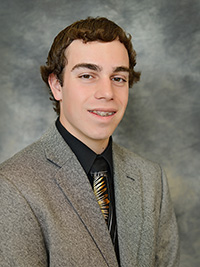What began as a routine writing assignment in a Freshman Tutorial may someday impact the Baseball Hall of Fame.
Justin Woodard ’19 was tasked to research a professional baseball player born in Indiana and determine if he is worthy of enshrinement in the National Baseball Hall of Fame and Museum.
He selected Charles “Babe” Adams, who pitched for 20 years in the big leagues with St. Louis and Pittsburgh (1906-26), largely as a curiosity. Why would someone share a nickname with one of the greatest players of all time?
 Adams won 194 games in that 20-year career, but what made him worthy of inspection, according to Woodard, was that this “Babe” was one of the most accurate pitchers in Major League Baseball history. In 2,995.1 career innings pitched, the right-hander walked just 430 batters – ranking 18th all-time in walks per 9 innings – to go with 1,036 strikeouts and a 2.76 ERA.
Adams won 194 games in that 20-year career, but what made him worthy of inspection, according to Woodard, was that this “Babe” was one of the most accurate pitchers in Major League Baseball history. In 2,995.1 career innings pitched, the right-hander walked just 430 batters – ranking 18th all-time in walks per 9 innings – to go with 1,036 strikeouts and a 2.76 ERA.
“His accuracy really impressed me,” said Woodard, who hails from Lebanon, IN.
What made Woodard’s effort more memorable is that most of the research was conducted last fall in Cooperstown, NY, at the Hall of Fame through the Baseball & the American Identity’s immersion trip. Every MLB player has a historical file at the Hall of Fame that contains newspaper clippings and biographical information (four of his sources were from the Hall’s archives). Students were also able to request materials from the Hall of Fame that might aid in the research process.
“Because Babe’s career started in the early 1900s, some of the materials the Hall of Fame possessed were pretty fragile,” explained Woodard. “In fact, to handle the majority of his player file material I had to wear gloves.”
The resulting paper, “The Original Babe and the Hall of Fame” was the college division winner of the 2016 Jack Cavanaugh Memorial Youth Baseball Research Award, which is given by the Society for American Baseball Research (SABR), which came with a $200 prize and a SABR membership.
“Going to the Hall of Fame was an amazing experience, but winning the SABR research award helps to bring the trip full circle by showing how helpful the class is to developing critical thinking and writing skills,” said Woodard.
After his visit to Cooperstown, Woodard couldn’t help but think of seeing Babe Adams recognized in those hallowed halls, perhaps with his research assistance.
“The idea of Adams possibly getting some type of exhibit or a spot in the plaque room is pretty indescribable,” Woodard concluded. “Cooperstown is such a historic place, and if I were able to impact it in some way, that would be something I would tell people about for the rest of my life.”